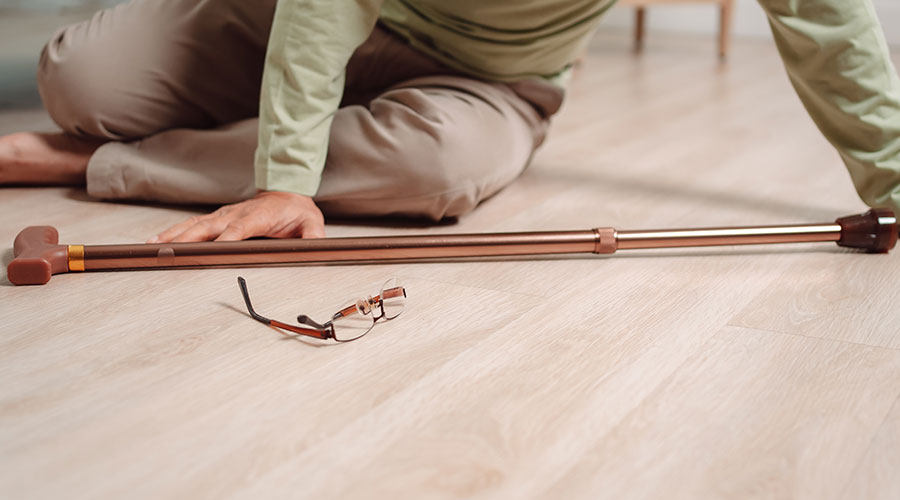In the early 2000’s you couldn’t watch TV without seeing a Life Alert commercial. For years, the phrase “Help! I’ve fallen and I can’t get up,” played throughout speakers across the country and spawned several spoofs and skits in popular media. Anytime someone tripped, slipped or fell, people were quick to say the phrase to the person. It was the company’s sole intention to market their product, but they brought the seriousness of falls into the zeitgeist.
As the commercial demonstrated, falling down can potentially cause an injury and it doesn’t matter how old you are. However, for elderly people, falls can have a detrimental impact on their lives. Russ Kendzior, president of NFSI, explains that falls are the leading cause for admittance into senior care facilities.
“The elderly are the most vulnerable for slips, trips and falls,” Kendzior says. “The leading cause of accidental death for people over the age of 70 are falls. The leading cause of emergency room visits – falls. Our country is getting older and falls are only going to happen more unless we do something about it.”
Over six million falls occur each year. This figure is especially problematic when it comes to senior care facilities as environmental hazards, such as slick floors, poor lighting and misplaced furniture can cause upward of 27 percent of falls among residents, according to law firm Sackrin & Tolchinsky. If a resident were to fall and hurt themselves, they could potentially sue the facility for the cost of their injuries. Knowing this, architects and designers have begun carefully selecting materials in these facilities that enhance safety and stability for residents and employees alike.
“For each project, we develop and meet with a Core Planning Group, which consists of representatives from different departments and the key stakeholders at the organization, every two weeks during the design process,” says Tu-Anh Bui Johnson, Wold Architects and Engineers. “Once we have a palette and general direction for the selected materials, we often present our findings and direction at Resident Council meetings. We have found that residents appreciate the interactive nature of these meetings and the ability to share input prior to the implementation of our design.”
When selecting materials, designers must start with two things: the environmental elements and the programming elements. Rockland Berg, principal at three, explains that programming elements are the potential and ultimate use of the inherent activities or programming that will occur in those spaces. Once that is recognized, then designers can decide what will influence those environments. Things to consider is if a particular space will be used as an indoor/outdoor space or if the area will have large service components next to them that generate moisture.
“Now, when we think about those environments and the programming, we need to think about the activities and who will be using the spaces,” Berg says. “We’re not just talking about senior living residents. We need to also think about their family members, either immediate children or hopefully even grandchildren who will be playing through these environments. We’re also thinking about the service and care providers as well. They’re all using these surfaces, but they’re also trying to maintain them as well.”
Before selecting products, designers should ask the organization for their material standards, preferences and cleaning practices. Flooring can be easily damaged if cleaning practices differ from what is recommended by manufacturers. At this stage, the Environmental Services (EVS) department can also be involved in any potential decision making to ensure housekeeping and janitorial needs align with the right materials for the project.
“Beyond aesthetics, two main objectives to consider when selecting flooring include ease of installation and maintenance for the staff,” Johnson says. “One issue that has come up frequently is supply chain disruption and the discontinuation of flooring materials and pattern types. To solve this issue, we aim to select similar potential replacement products with consistent wear layers and patterns so there won’t be a need to source brand-new materials later if the initial selection is discontinued.”
Even with this in mind, the materials that are selected can still be hazardous. Because of this, NFSI has petitioned the United States Consumer Product Safety Commission to initiate a rule mandating testing and labeling the slip resistance or traction of residential and commercial floor cleaning agents and consumer footwear. If passed, a label would show whether a product had high, moderate or low traction in accordance with the NFSI B101.5 Standard Guide for Uniform Labeling Method for Identifying the Wet Dynamic Coefficient of Friction (Traction) of Floor Coverings, Floor Coatings, Treatments, Commercial and Residential Floor Chemical Agents and Consumer Footwear.
“You have no idea when you’re buying a floor how slippery it is,” Kendzior says. “They [manufacturers] don’t test and they don’t label their products. You have no idea that every time you use a cleaning product on your floor that you’re only making it more slippery. There’s a need to protect the consumer, and our view is that they have the right to know when they’re buying products if they are contributing to a potential slip and fall.”
Tripping hazards can be reduced when flooring transitions are minimized. In cases where they are necessary, designers should specify flush transitions to ensure there’s no perceived dimensional difference between the two types of flooring, Johnson says.
Flooring isn’t the only thing that contributes to falls in senior care facilities, though. Proper lighting is crucial in these types of environments as aging eyes can perceive color tones differently. Lighting in senior care facilities needs to be designed with older adults in mind. Spaces with bright, natural light not only help reduce falls, but also increase socialization and stimulate positive physical and mental health.
“Lighting can help pick up and dictate how one perceives a service in terms of dark and light,” Berg says. “With seniors in particular, as the frailty of vision starts to become a greater factor, being able to perceive a dark space correctly or see it as a whole can be intimidating and problematic for transgressing on property. So, you’ve got to be thinking about what lighting will do with the colors that you’re providing, and does it provide enough light for a more frail vision environment?”
Managers should consider selecting warmer tones that can be easier on aging eyes and create a more comfortable living environment. Johnson suggests integrating motion-activated lighting in high-risk areas to ensure that residents are never left in the dark, further reducing the likelihood of falls. Combining thoughtful lighting design with an understanding of the unique needs of seniors will create an environment that supports both safety and wellness.
“We are migrating from the greatest generation, who have been on our threshold and walking into our communities with their children who are boomers,” Berg says. “The idea of choices and a desire for lots of choices and selections is there for creativity. I’m watching the market change and as an innovator and one who’s employing all the new technologies, whether it’s flooring, materials, lighting – it's sensitized to someone falling or spending too much time on a floor. There’s all these products out there that are smarter, communicative and can help provide a longer life for our seniors.”
Mackenna Moralez is the associate editor of the facilities market.

 Building Disaster Resilience Through Collaboration
Building Disaster Resilience Through Collaboration Amae Health Expands to New York City
Amae Health Expands to New York City Hospital for Special Surgery Opens Two New Facilities in New Jersey
Hospital for Special Surgery Opens Two New Facilities in New Jersey Should We Be Testing Toilet Water in Patient Restrooms?
Should We Be Testing Toilet Water in Patient Restrooms? Healthcare Union Petitions for Increased Staff Safety at HCA Florida Hospitals
Healthcare Union Petitions for Increased Staff Safety at HCA Florida Hospitals